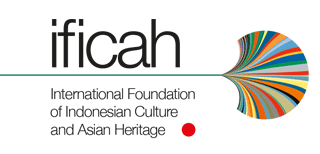Side-Knife “lunggai”
A knife (lunggai) of exceptional quality that can be considered a work of art in its own right and not just as an “accompanying implementation” of a mandau. The slender, long-stemmed handle made of highly polished stone-hard wood ends in a characteristically upward-curved end piece made of deer antlers, which is shaped like an expressive dragon’s head. The snout, which clearly shows the bleached rows of teeth and long fangs, merges into a large suspended spiral, symbolising the entrance and exit of the underworld represented by the dragon. Thus the expressiveness of the mandau handle is very clearly expressed. On the mighty head of the dragon, the main aso, huddles a human figure which is strongly withdrawn in terms of representation and which can be recognised by the limbs visible on both sides. On the neck, or the underside of the handle, the dragon’s throat, so to speak, rounded surfaces can be recognised as stylised skull motifs. The handle thus ideally summarises the “path of the warrior”: in front of the mouth of the earth dragon aso is the entrance and exit of the underworld, which is walked by the warrior / initiator and his victim alike, with the aim of calling up the life energy provided in the underworld. The egg-shaped elements at the base of the antlers-top, which are interrupted by attached spirals, might also be named as stylised limbs, probably the legs of the “rider”. The handle has a silver mount, which is chased in the Malay style with floral elements and is probably a work from Kutai or Brunei.
The blade, which has a back cut and is made of stringy refined steel, also appears to be Malay. It seems – typical for Malaysian blades – to have been deliberately etched. Obviously it is a very old piece. Atypical for nyu knives is the cutting edge, which is also Malaysian in style. On the whole, the blade is shaped as a “mini-mandau” and has an unusually elaborate design for a knife of this type. The very prominent aso on the end piece and the clear references to the transmigration or transformation of souls suggest an application in the context of rites de passage / rites of passage, such as circumcision (known to Dusun and Iban) or carving.
This knife has a well documented history and is historically significant. It was donated to the VKM Leiden collection in 1881, together with the accompanying mandau (former Inv. No. 261/2c; belonging to mandau 261/2). There is a coloured representation of the knife in Juynboll (part 2 plt XVIII). The donation is discussed in the Staatscourant as a “gift from the Sultan of Broenai to the Gouvernement of the Dutch Indies”. The history of the knife is described in ” Tijdschrift voor Nederlandsch Indie , deel 1, 01-06-1882″.
The mandau, to whose sheath the knife belonged, was applied with a ruby and a diamond. It was presented by the Sultan of Kutai to the commander of a Dutch warship around 1873 as an expression of the desire for friendly relations. During this time the Dutch again appeared more and more as “competitors” of the British Dent & Overbeck Company in North Borneo, which was protected by the Sultan and paid him commission for the rights to exploit the hinterland (rubber, tobacco, precious wood etc.). As Dent & Co’s ambitions grew and proved to be very lucrative, the Dutch sent ships to register rights as well. This put the Sultan in a difficult diplomatic situation, and in this context the mandau was handed over, along with other gifts, as a sign of good will, as described in Juynboll (ibid.) The mandau disappeared from the museum collection, probably by theft, over 50 years ago.
The imitation dessert reappeared on the antique market a few years ago and was recovered.


| Object | Side-Knife “nyu”, “lunggai” |
| Culture | Borneo West-, Kutai, Sabah, Dayak, Kenyah (?) |
| Time | 18th / 19th century |
| Dimensions | Length 42 cm |
| Material | Steel, silver, wood, stag horn |








